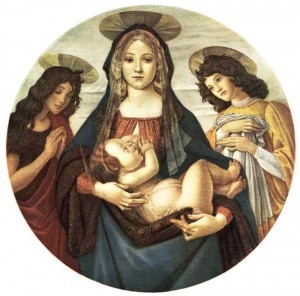>> a brief history on Botticelli:
Sandro Botticelli, who lived from 1445-1510, was an important painter during the early Renaissance. He lived in Italy and was initially an apprentice to a goldsmith as a boy, but found his true talent was in painting and became the apprentice of the master Filippo Lippi.
The Renaissance was a period of time from the 14th to the 17th century in Europe. This era bridged the time between the Middle Ages and modern times. The word “Renaissance” means “rebirth”. It was a rebirth of education, science, art, literature, music, and a better life for people in general.
The Greek and Roman Empires where times filled with art and enlightened thinking. When those empires fell, Europe was left in the Middle Ages or what we often call the Dark Ages because these advances were lost.
The Renaissance started in Italy, where powerful and wealthy people were willing to support artists (as well as other types of geniuses.) The Medicis were a very wealthy family that were the Patrons of our artist, Sandro Botticelli.
This is important because before the Renaissance, art was sponsored by the church and always depicted religious subjects. Now, artist were able to explore other topics. Greek and Roman mythology were popular during this time, religious art was still very popular, portraits of nobles were also common.
>>Show and discuss the aspects of the paintings with the kids. Ask them what they notice, what they like, dislike. Here some possible points:
Botticelli is known for the dreamy look of the people (and gods, goddess, and angels) in his paintings.
Look at the serene faces and balanced proportions of the pictures. How do they make you feel?
Do you think think Botticelli placed more importance on the people or the setting in his paintings?
*Display round paintings
These are call Tondo which comes from the Italian word rotondo or round.
Botticelli was a leading master of this style of painting, which was popular during the renaissance.
Notice how there is much less detail to the background, (if there is one at all).
See how the composition or where the people and other items in the picture are placed a little differently so that it flows with the circular shape.
*Show the large tondo (The Virgin and Child) and picture 698 (Adoration of the Magi)
What do you notice about this tondo compared to a rectangular painting?
>>Now to the activity:
We will create our own tondi (plural for tondo) the rim of the plate can make a frame.
Ask the kids to stop and think about a subject they would like to draw (Feel free to briefly discuss).
Remind them to keep it simple, do not try to fit too much in or make a complex background.
Show Madonna the Magnificent (in the I Spy book) and point out the way the youth and Madonna mirror the circular shape, how the arch above them frames and completes the circle. The background forms an interesting contrast to everything else.
Ask the kids to think how they can make their subject compliment the circular frame.
Show them how to lightly sketch in (or rough in) their picture then fill in with the pastels.
Artists always work from the background to foreground (The things in the back to the main subject in the front).
Show them how pastels can be used (Always press lightly! They break easily) and blended with their fingers. Pastels are not crayons. Tell them they will feel that they are oily. They are kind of like oil paint poured into a stick. The can give a lot of vibrant color if you press more firmly or very soft color that can be blended together if you press lightly.
>>Excuse them to sit and go to work.

